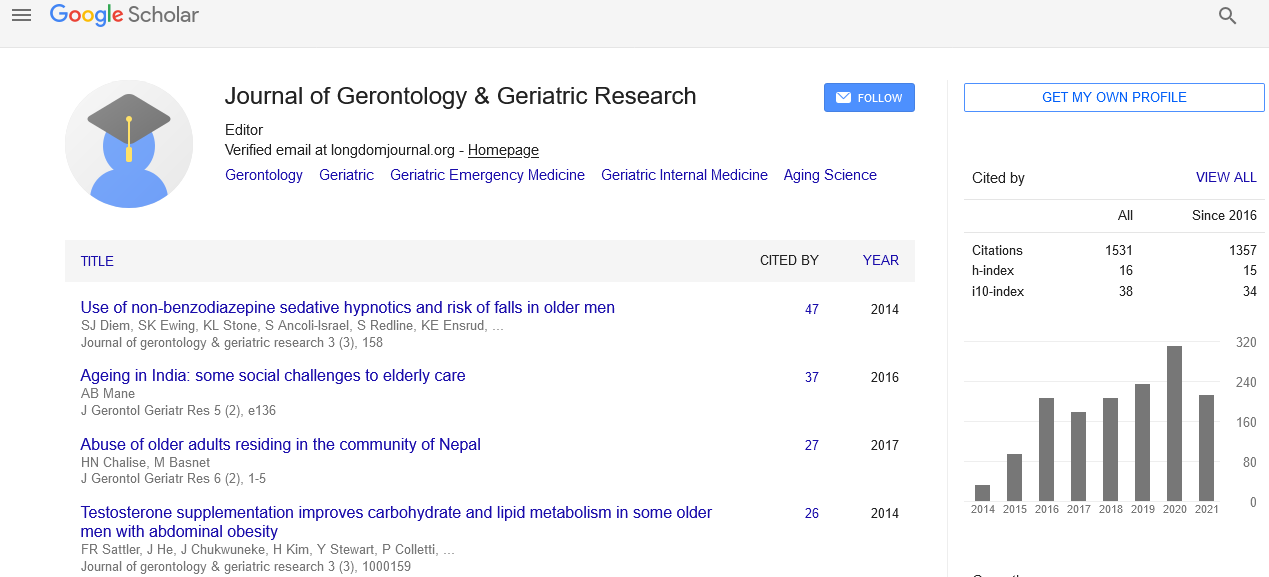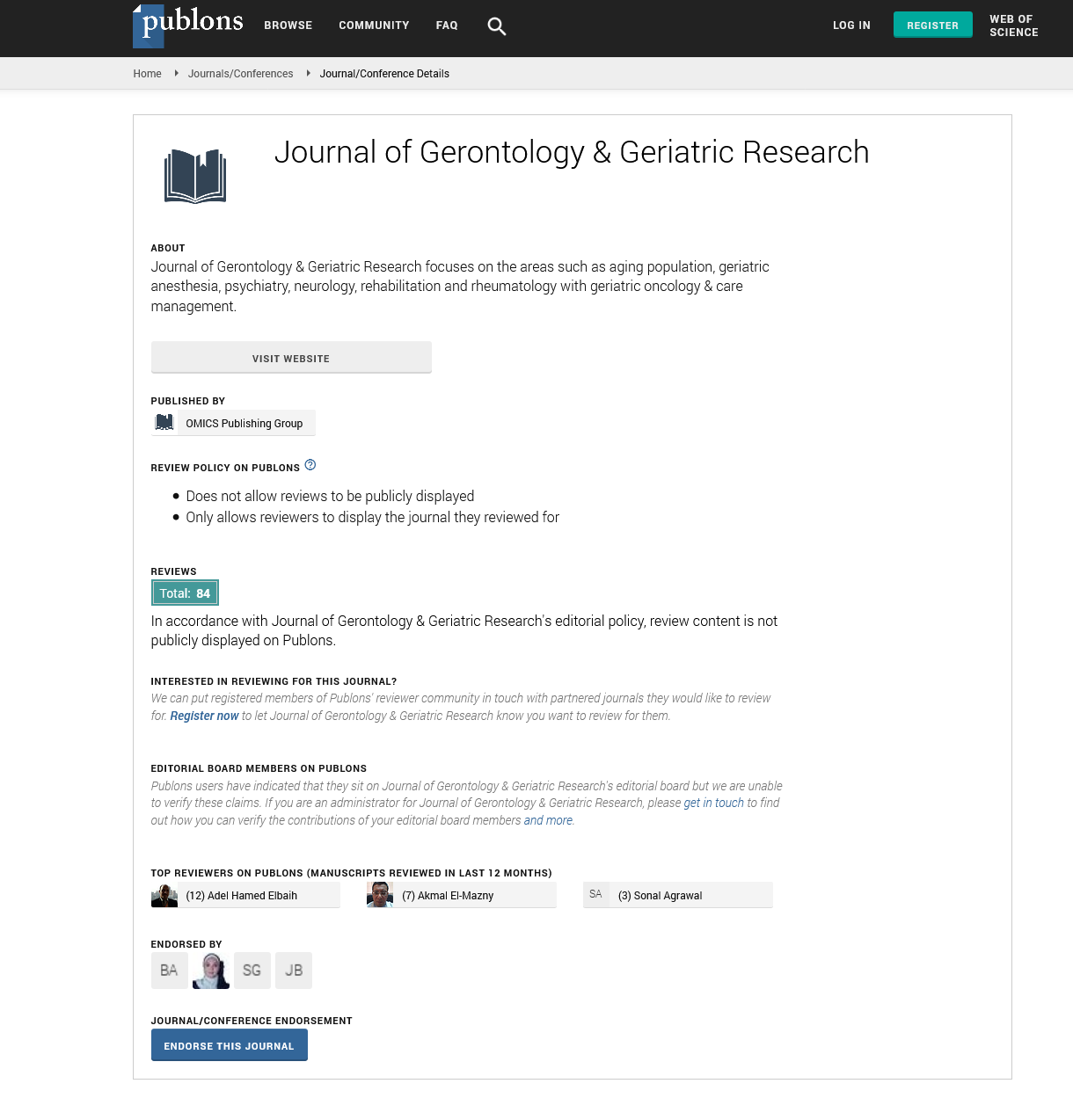PMC/PubMed Indexed Articles
Indexed In
- Open J Gate
- Genamics JournalSeek
- SafetyLit
- RefSeek
- Hamdard University
- EBSCO A-Z
- OCLC- WorldCat
- Publons
- Geneva Foundation for Medical Education and Research
- Euro Pub
- Google Scholar
Useful Links
Share This Page
Journal Flyer

Open Access Journals
- Agri and Aquaculture
- Biochemistry
- Bioinformatics & Systems Biology
- Business & Management
- Chemistry
- Clinical Sciences
- Engineering
- Food & Nutrition
- General Science
- Genetics & Molecular Biology
- Immunology & Microbiology
- Medical Sciences
- Neuroscience & Psychology
- Nursing & Health Care
- Pharmaceutical Sciences
Short Communication - (2023) Volume 12, Issue 5
Geriatric Syndromes: Diagnosis, Management and Prevention
Tora Roberts*Received: 02-Oct-2023, Manuscript No. jggr-23-23499; Editor assigned: 04-Oct-2023, Pre QC No. P-23499; Reviewed: 17-Oct-2023, QC No. Q-23499; Revised: 23-Oct-2023, Manuscript No. R-23499; Published: 30-Oct-2023, DOI: 10.35248/2167-7182.2023.12.695
Introduction
Aging is an inevitable part of the human experience. As we grow older, our bodies and minds undergo a natural transformation that can present both challenges and opportunities. While it is true that aging comes with its share of physical and cognitive changes, it is possible to age gracefully and maintain a high quality of life well into our geriatric years. In this comprehensive guide, we will explore various strategies for healthy geriatric living, encompassing physical, mental, emotional, and social aspects of aging. Before we delve into strategies for aging gracefully, it's essential to understand the science behind aging. Aging is a complex process influenced by various factors, including genetics, lifestyle, and environmental factors. Here, we'll explore the key biological and physiological aspects of aging.
Description
Understanding how these cellular structures affect aging and potential interventions. Mitochondrial Function: The role of mitochondria in cellular aging and strategies for optimizing mitochondrial health. The impact of hormonal shifts on aging, including menopause in women and andropause in men. Hormone Replacement Therapy (HRT) and its potential benefits and risks.
A balanced diet plays a crucial role in healthy geriatric living. Proper nutrition can help manage age-related conditions, maintain energy levels, and support overall well-being. Essential vitamins and minerals for promoting healthy aging, including vitamin D, B vitamins, and antioxidants. The role of a balanced diet in reducing the risk of age-related diseases. Mediterranean diet, DASH diet, and other eating patterns associated with longevity and vitality. Managing caloric intake and portion control for maintaining a healthy weight. The importance of adequate water intake for older adults. Recognizing signs of dehydration and prevention strategies [1].
Biomarkers are measurable indicators of disease progression or treatment response. Cerebrospinal Fluid (CSF) and neuroimaging biomarkers, such as Aβ and tau levels, are being used for early AD detection and tracking disease progression. Positron Emission Tomography (PET) scans can visualize Aβ plaques and tau tangles in the brain. These biomarkers aid in identifying individuals in the preclinical or prodromal stages of AD, allowing for timely interventions. Precision medicine approaches involve the development of drugs that target specific molecular pathways implicated in AD. For instance, anti-amyloid therapies aim to reduce Aβ production or promote its clearance from the brain. Monoclonal antibodies, such as aducanumab, target Aβ aggregates and have shown potential in clinical trials. Other targets include tau phosphorylation, neuroinflammation, and synaptic dysfunction. By tailoring interventions based on an individual's genetic and molecular profiles, researchers can enhance treatment efficacy and minimize adverse effects [2].
Precision medicine considers individual variations in drug metabolism and response. Pharmacogenomics explores how an individual's genetic makeup influences their response to medications. Genetic testing can identify gene variants that affect drug metabolism enzymes, helping clinicians choose the most appropriate and effective treatments for AD patients. This approach reduces the likelihood of adverse reactions and optimizes treatment outcomes.
Warm-up exercises, such as light stretching and low-intensity movements, should be performed before each workout session to prepare the muscles and joints for activity Proper form and technique during exercises are crucial to prevent injuries. If you are unfamiliar with certain exercises, seeking guidance from a qualified fitness professional or physical therapist can be beneficial. Lifestyle factors, including diet, exercise and cognitive stimulation, and sleep, can influence AD risk and progression. Precision medicine takes these factors into account and tailors lifestyle recommendations based on an individual's genetic and molecular profiles. For instance, individuals with a higher genetic risk might benefit from more intensive interventions, such as personalized exercise regimens or dietary plans rich in brain-healthy nutrients.
Precision medicine enhances the design of clinical trials by stratifying participants based on their genetic and molecular characteristics. This approach increases the likelihood of identifying responders to specific treatments, as well as predicting potential adverse reactions. Stratification also reduces variability within trial populations, leading to more accurate and informative results. Integrating large-scale genetic, molecular, and clinical data presents computational and analytical challenges. Developing robust algorithms and databases to interpret complex interactions between genes and molecules is essential for translating research findings into clinical practice. AD is a heterogeneous disease with diverse underlying mechanisms. Tailoring interventions based on genetic and molecular profiles requires a deep understanding of these variations to effectively target specific subtypes of the disease [3-5].
Conclusion
Aging gracefully is a multifaceted journey that involves nurturing physical health, mental acuity, emotional well-being, and social connections. While aging brings its own set of challenges, it also offers opportunities for growth, wisdom, and meaningful experiences. By adopting the strategies outlined in this guide and embracing the aging process with grace, older adults can look forward to a fulfilling and vibrant life in their geriatric years. It's important to remember that every individual's aging experience is unique. What works for one person may not work for another. Therefore, the key to aging gracefully is to personalize these strategies to fit your own needs, preferences, and circumstances. With the right approach and a positive mind set, the journey of aging can be a rewarding and enriching one.
Acknowledgement
None.
Conflict of Interest
None.
References
- Brouillet E, Hantraye P, Ferrante RJ, Dolan R, Leroy-Willig A, Kowall NW, et al. Chronic mitochondrial energy impairment produces selective striatal degeneration and abnormal choreiform movements in primates. Proc Natl Acad Si 1995; 92:7105-109.
- Jack Jr CR, Holtzman DM, Sperling R. Dementia is not synonymous with Alzheimer’s disease. Am Assoc Adv Sci 2019; 11:0511.
- Johnson KA, Schultz A, Betensky RA, Becker JA, Sepulcre J, Rentz D, et al. Tau positron emission tomographic imaging in aging and early A lzheimer disease. Ann Neurol 2016; 79:110-119.
- Blennow K. A review of fluid biomarkers for Alzheimer’s disease: Moving from CSF to blood. Neurol Ther 2017; 6:15-24.
- Teunissen CE, Verberk IM, Thijssen EH, Vermunt L, Hansson O, Zetterberg H. Blood-based biomarkers for Alzheimer's disease: Towards clinical implementation. Lancet Neurol 2022; 21:66-77.
Google Scholar, Crossref, Indexed at
Google Scholar, Crossref, Indexed at
Google Scholar, Crossref, Indexed at
Google Scholar, Crossref, Indexed at
Citation: Roberts T (2023). Geriatric Syndromes: Diagnosis, Management and Prevention. J Gerontol Geriatr Res.12:695.
Copyright: © 2023 Roberts T. This is an open-access article distributed under the terms of the Creative Commons Attribution License, which permits unrestricted use, distribution, and reproduction in any medium, provided the original author and source are credited.


